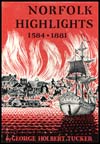Chapter 31
Historic Fort Norfolk
Fort Norfolk, a bastion that never blazed away at an enemy, houses one of the oldest government agencies in the Norfolk area.
Established during the Revolution, the fort was the headquarters for the defense of Norfolk in the War of 1812, saw the Virginia (Merrimack) steam down to Hampton Roads in 1862 for her historic encounter with the Monitor, served as a Civil War prision, and finally became the headquarters of the Norfolk District of the Army Corps of Engineers in 1923.
In point of age, Fort Norfolk is only a few months younger than the agency it houses within its thick, old, whitewashed walls. The Corps of Engineers was established on June 16, 1775, a few months before the fort was begun.
Located at that point on the Elizabeth River known as "The Narrows," where the river fans out to the eastward to form Norfolk's inner harbor, Fort Norfolk is opposite the Portsmouth Naval Hospital, the site of Fort Nelson, another Revolutionary fort. Although Fort Nelson was still in good condition in 1824, when an Army survey of both forts was made, all traces of it have disappeared. Fort Norfolk, however, except for the addition of a few modern buildings, is practically the same as it was then.
Fort Norfolk was established by the State of Virginia shortly after the burning of Norfolk in January of 1776. The Virginia forces, however, made the mistake of manning it too lightly. And when Sir George Collier sailed up the Elizabeth River in May of 1779 with a large British fleet, the garrison was unable to offer any resistance.
On March 4, 1794, President George Washington was authorized to build a series of forts to protect nineteen United States harbors. One year later, on May 21, 1795, Edward and Sarah Poole sold the property on which the Revolutionary fort had stood to the United States government for two hundred pounds sterling, after which Fort Norfolk as it appears today was begun.
In 1807, when the second war with Great Britain was brewing, the people of Norfolk began to fortify the city and put Fort Norfolk in repair. Large quantities of gunpowder and stores were collected there, and a heavy chain was stretched across the river from the fort to Fort Nelson to prevent British warships from entering Norfolk's inner harbor.
War did not come to the Norfolk area, however, until February of 1813, when Admiral Sir George Cockburn brought a British squadron into the Virginia Capes to blockade the Chesapeake Bay. Ahead of the British squadron fled the U.S. frigate Constellation, crowding on every available inch of canvas to reach the protection of the guns of Fort Norfolk. In her haste, she missed the channel and ran aground, but hundreds of Norfolk citizens came down the river in small boats and lightened her until she floated to safety.
The Constellation remained at Norfolk throughout the war, aiding greatly in its defense with her officers, crew, guns, and small boats.
General Robert Barraud Taylor, later the first judge of the Superior Court of Law and Chancery for the Borough of Norfolk, the forerunner of the present Norfolk Court of Law and Chancery, was Fort Norfolk's commander during the exciting times of 1812-1814.
Following the war of 1812, Fort Norfolk's history was humdrum until the Civil War, when a Confederate battery was erected there. After the fall of Norfolk to the Federal forces in May of 1862, it was used by them as a prison until March of 1863, when General Benjamin F. Butler transferred it to the Navy. The Navy retained the fort for many decades, although the Army Corps of Engineers made use of it at various times. It was formally turned over to the Corps of Engineers in 1923, and the damage caused by years of neglect began to be repaired. The site now constitutes a quiet, green oasis on the northern side of the Elizabeth River's hustle and bustle of heavy traffic.
Note: Since the publication of Norfolk Highlights, the Norfolk Historical Society has overseen extensive renovations to Fort Norfolk.
Chapter
32
The Battle of Craney Island
Norfolk Highlights 1584 - 1881

See the "Table of Contents" for links to every chapter in Norfolk Highlights 1584 - 1881 by George Holbert Tucker.
